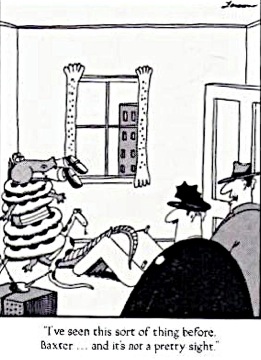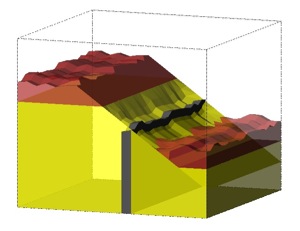
Introduction and Background
This page will tell you how to use the Geo-Time-Machine, a learning tool developed at Iowa State University. This tool (called GTM from now on), will help beginning geology students to understand several important concepts connected to the concept of relative geologic time.
What is relative geologic time?
When the surface of the earth is shaped by geologic processes, such as erosion, sedimentation, faulting and rock intrusions from below, we could think of a puzzle being created over time: each process changes in some way what came before it - the result is a the accumulation of effects. We as geologists are faced with unraveling this puzzle with regard to what process happened when, similar to the "crime" shown in this cartoon. Try it: what happened first (at time step 1), what happened then (time step 2) and what happened last (time step 3)?

As geologists we are in a similar situation, we can only see the final picture and we need to roll back time until we know what the sequence of events produced that final picture. Luckily for you, we have provided you with a Geo-Time-Machine (GTM) to go back (and foreword) in time. Although we usually cannot determine the absolute time of geologic events (i.e., event X happened 2 million years ago and later event Y happened 1 million years ago), we can try to reconstruct the relative sequence of processes - hence the term relative geologic time.
The GTM learning tool we will deal with four geologic processes:
-
•Erosion
-
•Sedimentation
-
•Faulting
-
•Rock intrusions
These processes will be used to demonstrate several fundamental principles of geology:
-
•The Principle of Superposition
-
•The Principle of Cross-cutting Relationships
-
•The Principle of Intrusive Relationships
If you need a refresher see this page under Important principles of geology. We will deal with these processes and principles in more detail later.
Usually students learn about relative time using 2D sketches and block diagrams and a test might give them a diagram and ask 'What happened and in what order?' (sounds familiar?). The goal of the GTM is to enable you to look at the 3D computer graphics equivalent of a block diagram and answer these two questions because you can see how the processes and the evidence they left over time are connected. Hopefully you will agree that this is a pretty interesting way of learning.

